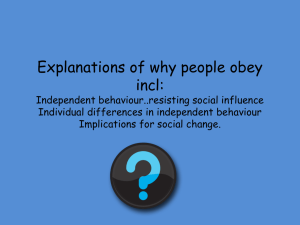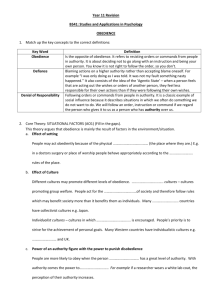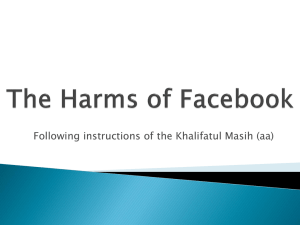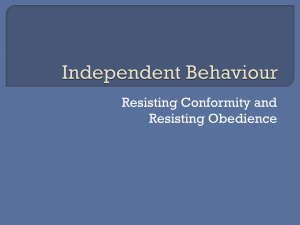Obedience Booklet - Accrington Academy
advertisement
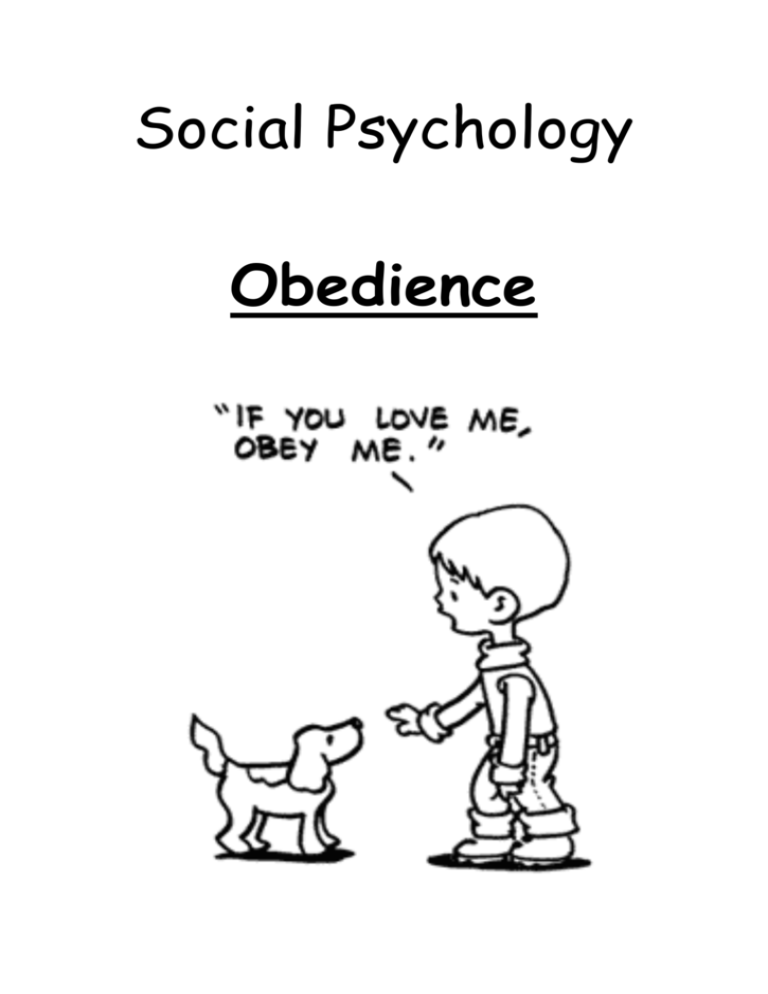
Social Psychology Obedience Unit one: Obedience Key concepts Candidates should be able to: • distinguish between obedience and defiance; • explain what is meant by the term ‘denial of responsibility’. Core theory: theory of situational factors Candidates should be able to: • explain the effect of environment on obedience, ie setting, culture; • explain the effect of authority and the power to punish on obedience; • explain the effect of consensus on obedience; • explain the criticisms of situational factors as an explanation of obedience; Alternative theory: theory of dispositional factors Candidates should be able to: • consider dispositional factors as an alternative theory, with specific reference to the role of the authoritarian personality in obedience. Core study: Bickman (1974) Candidates should be able to: • describe Bickman’s field experiment into effects of uniform; • outline limitations of Bickman’s study. Application of research into obedience: keeping order in institutions and situations Candidates should be able to: • explain how psychological research relates to keeping order in institutions, eg use of punishment in schools, use of authority in armed forces, effect of prison setting. Key terms Obedience Following orders or commands, doing as you are told Authority A person who has a level of power or status Defiance Refusing to follow orders or commands, not doing as you are told Denial of responsibility Blaming actions on others, saying you did something because you were told to do it Core theory: Situational factors Situational factors include the setting or environment, the authority of the person giving the instruction, culture and consensus. The following experiment is not the situational factors theory, but it can be used to explain how environment and authority impact on obedience so it is useful to know. Milgram asked volunteers to take part in a study about learning (it was really about obedience). When the volunteers came to the laboratory, they were introduced to Mr Wallace (a confederate), they then were assigned the role of teacher and learner (the participant was always the teacher) by a research who was wearing a white lab coat. The participant was then shown Mr Wallace being hooked up to an electric shock generator and it was explained to them that they would have to read Mr Wallace a list of word pairs, he would then have to match up the word pairs once he had been read the whole list. If he got a pair wrong, the participant had to give him a shock (by pressing a button in the connecting room). 65% of the participants gave Mr Wallace shocks up to 450 volts even though it said ‘XXX’ next to it, all of the participants went up to 300 volts. Environment Milgram’s study was carried out in a well-known American University in a smart laboratory. He replicated his experiment in a rundown office block to see if the setting (or environment) impacted on obedience. He found that when the experiment was in the run down office block, only 47% of participants gave Mr Wallace shocks of 450 volts (compared to 65% in the university lab). This suggests that when we are in nice surroundings, we are more likely to be obedient. Authority In Milgram’s study, the researcher was wearing a white lab coat, this gave them authority over the participant. As the researcher gave the participant instructions and encouraged them to continue with the experiment, their authority may have led to obedience. Another study which shows the effect of authority was carried out by Hofling. In this study, nurses in a hospital received a telephone call from a Dr. Smith (there was no such doctor at the hospital, it was a made up name). Dr. Smith gave the nurse who answered instructions to give a dose of medicine to a patient. 21 out of 22 nurses obeyed the instruction even though it went against hospital protocol (the doctor should have filled out a paper form and the dose he asked the nurse to give was double that stated on the bottle of the medicine). This shows that in a hospital setting, the nurses followed the instruction because it came from a doctor who they felt had authority over them. There is thought to be a link between authority and the power to punish disobedience. We are more likely to obey if we think we will be punished for disobeying. Culture Psychologists believe that people can be divided into two main cultures, individualist and collectivist. Individualist cultures are societies where people are encouraged to be independent and self reliant e.g. USA. Whilst collectivist cultures are societies in which people share more tasks, belongings and income, they are often thought of as societies where people live in larger family groups, e.g. India. Milgram carried out his study in a number of countries and found that people who are from individualist cultures are less likely to obey, this could be because they are encouraged from a young age to think of their own needs and wants before others. Consensus Simply having other people around us may make us less likely to obey if they support our decision. However, it has also been found that if other people are obeying, we are likely to ‘follow the crowd’ and also obey. This can work either way depending on the nature of the group we are in. Milgram investigated this by repeating his experiment but including two more ‘participants’ (who were actually also confederates) who purposefully disobeyed and refused to give Mr Wallace shocks. In this situation, only 10% of real participants shocked Mr Wallace up to 450 volts. This shows that support from others can give us the confidence to disobey. Criticisms There are a number of limitations with situational factors theory A limitation of this theory is that it ignores the fact that people have personalities. It suggests that the only things effecting whether or not we obey are external factors (setting, authority of who’s asking etc). It may be the case that some people are naturally more likely to obey than others. We all know of people who will refuse to do as they are asked just because they have been asked to do something! Another limitation is that most of the research this theory is based around has very low ecological validity. Milgram’s experiment is not something that anyone would ever be asked to do in day to day real life. This means that we could argue that they results are not valid enough for us to base a theory. The study conducted by Hofling has higher ecological validity as it was set in a real hospital, however it can still only be applied to nurses. Lastly there are ethical problems with the research that this theory is based on. Most of the research involved deceiving participants and some studies left participants distressed. We would not be able to replicate these studies now. Alternative theory: Dispositional factors This theory suggests that it is a person’s personality that impacts on their likelihood to obey. Adorno and his colleagues wanted to investigate why so many Nazi soldiers obeyed during the Holocaust. They decided that there was such a thing as a personality that made you more likely to obey. They tested this using the f-scale (f=fascism) in which they asked people to rate how they felt about a number of statements. He decided that people who scored highly on this scale had authoritarian personalities. People with authoritarian personalities are more likely (according to Adorno) to see things as being right or wrong (good or evil), be more prejudiced, dislike people from lower social classes, dislike uncertainty be willing to be bossed around by those with authority over them (to obey) Adorno claimed that this stemmed from childhood and that these people were taught to fear and obey authority from a young age. If this is all confusing, just remember, people who have an authoritarian personality are more likely to obey. Core study: Bickman (1974) Aim To investigate if uniform (appearance) has an impact on obedience. Procedure This was a field experiment set on a street in Brooklyn, New York. 3 male confederates took it in turns to dress in 3 uniforms. A guard uniform (looked like a policeman to us), a milkman’s uniform and civilian clothes which were a shirt, jacket and tie. They stood on the street one at a time and asked people who were walking past on their own to do one of the following things. To pick up some litter, to put some money into a parking meter for someone else, or to stand the other side of the bus stop. In total, they asked 153 people. Results Bickman found that people were more likely to obey when the confederate was dressed as a guard and were least likely to obey when the confederate was dressed as a civilian. Conclusion Certain types of uniform give the person wearing it authority. We are more likely to obey someone if we feel that they may be able to punish us for disobeying. Criticisms/Limitations There was a lack of control over the variables. Other factors such as crowds, noise and weather may have impacted on peoples likelihood to obey. Participants were selected through opportunity sampling, anyone who walked along the street on their own became a participant. We don’t know if people were in a rush, having a bad day or thinking about something else. These things could have effected whether or not someone obeyed. This also made the study unethical as participants were not asked if they wanted to take part before they were included in the study. The confederates who gave the orders were all men. If women were wearing the uniforms and asking passersby to do things, we may have different results. Being male may have given the confederate more authority anyway. Lastly, the study was only carried out on one street in one city, perhaps people in Brooklyn in New York are generally not as obedient as people in Bristol? We don’t know, this makes the research culturally biased. Applications of research: Keeping order in institutions and situations Research has shown that there is an effect of authority on obedience, due to this, many cultures and institutions have a hierarchy. A hierarchy is a structure of an organisation, group or culture where the person at the top has the most authority and individuals are likely to obey anyone above them. For example, in a supermarket, there is the manager, then the assistant manager, then full time staff, then part time staff. Everyone is more likely to obey the person above them and feel that they have some kind of authority over those below them. Prisons It is important for order to be kept in prisons and there are a number of ways by which this is done. Prisons have a very clear hierarchy, this is shown in the staffing, but also amongst inmates. Uniforms are also used in order to keep order. Having uniforms for staff enables them to be easily identifiable, their uniforms are much nicer and smarter than those of inmates which gives them instant authority. However, by having inmates in uniforms which take away their sense of identity, they may feel as though they could be more defiant. Punishments are also used in prisons to give guards authority. They have the power to punish inmates if they do not obey. Lastly, by keeping inmates isolated (even just in separate cells at night) it makes it harder for them to form a consensus and encourage each other to disobey. Armed forces The armed forces also have a very clear hierarchy, this ensures that individuals know who to look to for instruction. Uniforms are used again, as are punishments for those who disobey. School Again, all the same things are used in schools, there is a hierarchy, uniforms and punishments. Some of these things are more effective than others. Try to have an example ready for the exam.
